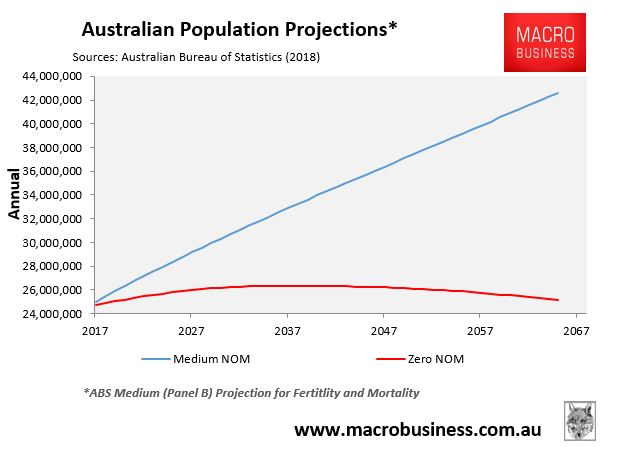Australia’s population growth has for more than a decade lead the world and is on track to nearly double the nation’s population to a projected 43 million people by 2066:

And this will be driven by annual population growth that is roughly twice as high as the post-war average, due to mass immigration:

Over the weekend, Fairfax’s Caitlin Fitzsimmons penned an article explaining why environmentalists like her never admit that limiting population growth, via reducing immigration, is the best way to safeguard Australia’s environment:
There’s a reason why I didn’t focus on population – it’s not simple and there’s no quick fix…
What about Australia’s population? The main driver of growth is immigration and, to a lesser extent, longevity.
There are many voters who want to reduce immigration and sometimes environmental sustainability is given as the reason. While large, Australia has delicate ecology and a scarcity of water and fertile land…
It’s hard to have a proper debate about population in Australia, because it’s inevitably about immigration and then it usually becomes about race and racism…
So what happens if you look at Australia’s population purely through the environmental prism?
The truth is Australia’s environmental record has very little to do with our population. We only have 25 million people but we have an appalling record on land clearing and extinction since 1788…
If you want to talk about population as part of a holistic plan to save the natural world, I’m all for it. But using it as an excuse for business as usual is delusional.
This is a cop out by Caitlin Fitzsimmons.
The first national report on the State of the Environment was delivered in 1996 and stated that Australians are not living sustainably, and that all of the country’s environmental problems are more or less proportional to the number of residents, as well as the material standard in which we live:
The problems are the cumulative consequences of population growth and distribution, lifestyles, technologies and demands on natural resources over the last 200 years and more.
The latest State of the Environment report, also prepared by independent experts, was published in 2016 and similarly found that population growth is a key driver of Australia’s environmental problems:
The key contemporary drivers of Australian environmental change considered in state of the environment (SoE) 2016 are population (demographic change) and economic activity…
Continued growth in Australia’s population and economy, including to meet demand for exports, is likely to increase pressures on the Australian environment…
The concentration of Australia’s population near the coast, mostly in urban areas, creates substantial pressure on coastal ecosystems and environments in the east, south-east and south-west of the country.
These aren’t the only environmental studies to draw the direct link between population growth and environmental degradation.
In 2010, the Australian Conservation Foundation (ACF) called for Australia’s population to be stabilised and nominated human population growth as a “key threatening process” to Australia’s biodiversity.
And last year, a team of scientists published their recommendations for slowing current rates of biodiversity loss in a paper in Nature Ecology and Evolution, which included limiting human population growth.
Since the first State of the Environment report was delivered in 1996, Australia’s population has ballooned from 18.3 million to more than 25 million. Moreover, the ABS’ medium projection is for Australia’s population to balloon to nearly 43 million by 2066 (see above chart). Such massive growth in people (consumers) will inevitably have devastating impacts for Australia’s environment, even if consumption per head is reduced
There would appear to be few better policy solutions to help protect Australia’s environment than abandoning plans for a ‘Big Australia’.

